The second in an interview series with participants in the 5th Frugivore and Seed Dispersal International Symposium.
Without seed dispersal plants could not survive. Seed dispersal—i.e. birds spreading seeds or wind carrying seeds—means the mechanism by which a seed is moved from its parent tree to a new area; if fortunate the seed will sprout in its new resting place, produce a plant which will eventually seed, and the process will begin anew. But in the face of vast human changes—including deforestation, urbanization, agriculture, and pasture lands—as well as the rising specter of climate change, researchers wonder how plants will survive, let alone thrive, in the future?
Seed dispersal research, a rather new discipline, is vitally important since the process underpins all the ecological interactions of a forest.
“Seed dispersal plays a very special role in the life cycle of most terrestrial higher plants. It connects generations. It is the only opportunity for a plant to move away from its kins and to a site that is favorable for its establishment,” Dr. Arndt Hampe with the Donana Biological Station in Spain explained to mongabay.com in a recent interview.
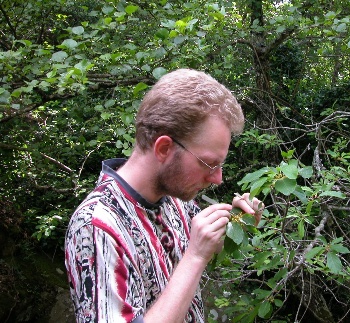 Ecologist Arndt Hampe in the field. Photo courtesy of Arndt Hampe. |
Arndt, a plant population ecologist and evolutionary biologist, focuses on seed dispersal in temperate and Mediterranean regions; he has recently become interested in how climate change will affect seed dispersal, which in turn points to how a warming world will affect forest ecosystems in total.
Yet, seed dispersal has proven to be incredibly complex and, perhaps, impossible to follow in real time. While models can be made of seed dispersal processes, these are problematic since even researchers don’t yet know all the different components that make-up and impact successful seed dispersal.
“Just imagine that a single oak tree can produce perhaps 5 million acorns during its life. Only a handful of them (or perhaps none at all) will ever reach maturity and produce another generation,” Hampe points out. “Now imagine how many oak trees you have to screen if you wish to detect and monitor those fortunate acorns that some day eventually travel kilometers away, grow up to adult trees, and produce offspring that finally founds another stand.”
Even with its inherent complexity, however, general patterns of how climate change is affecting seed dispersal—and plant species in general—is becoming clearer.
“Abundant evidence indicates that many species worldwide are currently colonizing higher latitudes and altitudes,” Hampe says, adding that “however, tracking this colonization in real time is extremely difficult, and detecting precisely those seed dispersal events that result in the establishment of new populations is right out impossible. Hence, our current knowledge stems mostly from indirect approaches such as population genetic surveys and simulation studies.”
.350.jpg) Jay flying with acorn: one example of seed dispersal. Photo by Ran Schols. |
While plants have survived climate shift in the past, the concern for Hampe is how will plants adapt to a changing climate in the face of a vast transformation to ecosystems by humans?
“Landscape connectivity is definitely a key factor. Climate changes, even rapid ones, are by no means a new phenomenon but have occurred throughout the earth’s history. The new challenge for biodiversity consists in the fact that vast landscapes have been transformed by human activity, severely reducing the connectivity of populations and the spaces available for colonization. Ex-situ conservation [i.e. captive] measures may help in some specific cases, although I think the potential of this option is very limited in comparison with the scale of problems we have to expect for the coming decades,” Hampe says.
In an April 2010 interview mongabay.com spoke with Arndt Hampe about the process of seed dispersal, plant survival in the face of climate change and other human impacts, and the importance of pioneering populations.
INTERVIEW WITH ARNDT HAMPE
Mongabay: What is your background?
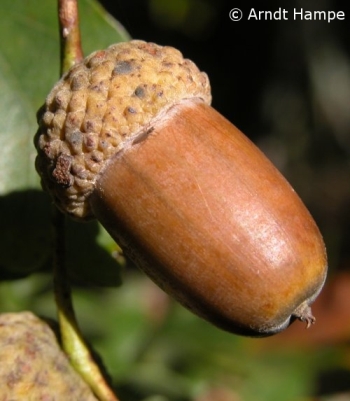 The acorn of an English oak (Quercus robur). Photo by Arndt Hampe. |
Arndt Hampe: I am a plant population ecologist and evolutionary biologist. Originally a pure field ecologist, I have successively incorporated molecular ecological approaches to my work and am attempting to integrate both perspectives. Some years of work in plant phylogeography [how geography influences species’ genetics] have moreover provided me with inspiring insights into population dynamics at large spatial and temporal scales. This is especially useful because long-lived, woody plants are my favorite study organisms.
Mongabay: How did you become interested in seed dispersal?
Arndt Hampe: In the same way as many of my colleagues: interested both in birds and plants since I was a youngster, I got attracted by the conspicuous interaction between fleshy-fruited shrubs and frugivores. Once you start to investigate this interaction, you quickly feel that its ecological consequences seem to be much more relevant for the plant side than for the animals. Et voilà.
Mongabay: What are some of the general differences between seed dispersal in temperate forests versus the tropics?
Arndt Hampe: Two major differences that come to my mind concern seasonality and species diversity. Both are intrinsically linked. By far most tree species in tropical (moist) forests rely on vertebrates for the dispersal of their seeds, and numerous dispersers feed year-round on fruit diets. This would be impossible in temperate forests, where fruits are only available during certain periods of the year and specialist frugivores would quickly starve. As a consequence, the frequency and variety of fruit-frugivore interactions tends to be lower in temperate forests. In fact, many important temperate forest trees have their seeds dispersed by abiotic vectors such as wind.
SEED DISPERSAL AND CLIMATE CHANGE
Mongabay: Why is seed dispersal such an important component of temperate forest ecology?
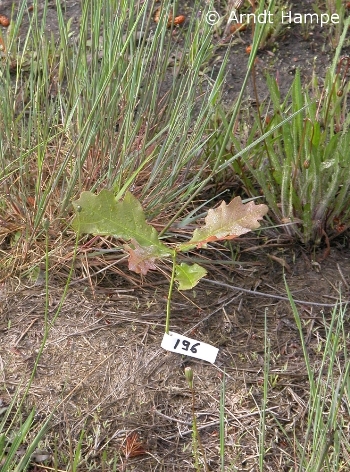 The seedling of an English oak (Quercus robur). Photo by Arndt Hampe. |
Arndt Hampe: Seed dispersal plays a very special role in the life cycle of most terrestrial higher plants. It connects generations. It is the only opportunity for a plant to move away from its kins and to a site that is favorable for its establishment. At population or community level, seed dispersal represents the initial template from which any regeneration starts. Demographic processes during later stages of plant recruitment may completely change the original spatial distribution of seeds, and it remains an object of debate how important patterns of seed dispersal really are for the dynamics of established forests. However, no regeneration can ever occur where no seed arrives, and this constraint may have important consequences for vegetation dynamics and community composition at local to landscape scale.
The implications of seed dispersal patterns concern forests worldwide, but they were especially relevant during the expansion of temperate and boreal forests after the Last Glacial Maximum (some 20,000 years BP). Disciplines such as palaeoecology [using fossils to reconstruct past ecosystems] and phylogeography have helped elucidate how this poleward expansion occurred. Today we know that such expansions were by no means deterministic but contained a strong stochastic [i.e. random] component. Seed dispersal, especially rare long-distance seed movements, have apparently played a key role in species’ colonization of the vast spaces that became available after the retreat of the glaciers – or in their failure to colonize them.
One particularly illustrative case comes to my mind in this context. It has been speculated that frequent long-distance seed dispersal by the passenger pigeon (Ectopistes migratorius) could have been key for the postglacial range expansion of many North American oak species. Sadly, the passenger pigeon went from being one of the most abundant birds in the world when Europeans arrived in North America to extinction in the early 20th century. Hence, oaks will need to find somebody else for carrying their seeds towards the north after the next glaciation. And we can be sure that the next postglacial expansion of oaks across North America will occur very differently than the last one.
Mongabay: Since seed dispersal is one of the major way in which plants spread, why do you think there have been so few studies looking at the efficacy of seed dispersal in a changing climate?
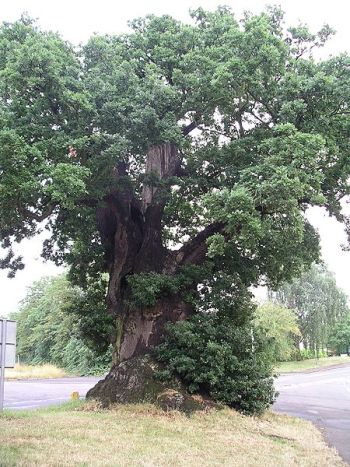 An English oak (Quercus robur) growing in Baginton. |
Arndt Hampe: Abundant evidence indicates that many species worldwide are currently colonizing higher latitudes and altitudes. However, tracking this colonization in real time is extremely difficult, and detecting precisely those seed dispersal events that result in the establishment of new populations is right out impossible. Hence, our current knowledge stems mostly from indirect approaches such as population genetic surveys and simulation studies. These approaches have allowed us to reconstruct colonization events of the past, but their informative value with respect to modern climate change is limited.
For instance, genetic data tell nothing about all those dispersal events that did not result in successful colonizations, so we cannot know what characterizes those events that did. But most importantly, past colonization processes occurred under very different (and only roughly known) environmental conditions. It therefore remains very unclear to which extent results can be transferred to our current situation, with highly transformed landscapes, impoverished disperser communities, and very rapid climatic change.
Mongabay: Why is it difficult to collect sound data on how climate change is affecting seed dispersal?
Arndt Hampe: Just imagine that a single oak tree can produce perhaps 5 million acorns during its life. Only a handful of them (or perhaps none at all) will ever reach maturity and produce another generation. Now imagine how many oak trees you have to screen if you wish to detect and monitor those fortunate acorns that some day eventually travel kilometers away, grow up to adult trees, and produce offspring that finally founds another stand…
Linking seed dispersal with population dynamics at a landscape to continental level requires integrating processes that occur at very different spatial and temporal scales. Moreover, many of these processes escape direct observation. Monitoring the population dynamics of long-lived, woody plants exceeds the professional life expectancy of ecologists. And except for sudden diebacks, it usually is very difficult to establish clear links between changes in population dynamics and in climatic conditions. Experiments can help to some limited extent but extrapolating their results to forest dynamics at a landscape scale is a tricky task. Indirect methods such as population genetic surveys and simulation studies have greatly helped with drawing a general picture of the role of seed dispersal in a changing climate, yet they represent simplifications that may easily miss important factors (or perhaps simply downplay the importance of stochasticity [i.e. randomness]).
Mongabay: What are some of the expected effects that climate change will have on plants that must migrate through seed dispersal?
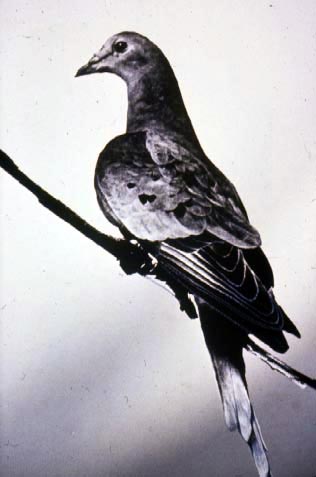 The now extinct Passenger Pigeon, which was likely a great seed disperser. Photo shows last known Passenger Pigeon, Martha, from 1914. |
Arndt Hampe: A great concern exists that numerous plant species could not be mobile enough to track suitable environmental conditions in pace with a rapidly changing climate, being finally condemned to extinction. Other species may face a reduction or increasing fragmentation of those areas that can sustain viable populations (e.g., alpine or coastal plants).
Moreover, shifts of distribution ranges arise from the establishment of new populations at the high-latitudinal range limit and extinctions at the low-latitudinal limit. Hence, even those species that manage to shift their range in pace with a rapidly changing climate will not escape massive population extinctions with the corresponding loss of genetic diversity and evolutionary history. At the community level, climate changes contribute to reshuffle the composition and abundance of species. Mobile generalist species will probably benefit most from rapidly changing environmental conditions, while little mobile specialists depending on particular habitats will be most negatively affected.
Mongabay: Why are pioneering populations so important in terms of climate change?
Arndt Hampe: Genetic studies indicate that range expansions often involve long-distance dispersal events that result in the foundation of pioneer populations ahead of the continuous species range. These populations quickly grow and fill the empty space with their offspring. Subsequent colonizations are likely to originate from populations near the advancing front, and the process can repeat itself many times. Hence, those individuals that are fortunate enough to participate in the initial stages of a range expansion can potentially fill vast spaces with their descendants. This phenomenon becomes most visible when we follow the fate of mutations that arise near the front of expansion. They may “surf” on the wave of advance and become much more frequent than they ever would within stable populations. Hence, pioneer populations are also efficient potential sources of microevolutionary change [small changes below the species level] and adaptation.
Mongabay: Do some species appear to have more effective pioneering populations? How would this restructure ecosystems?
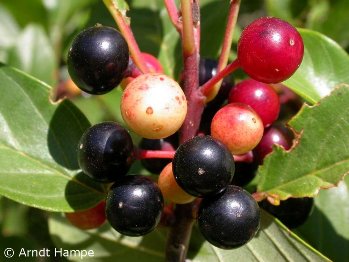 The fruits of the Glossy buckthorn or Frangula alnus. Photo courtesy of Arndt Hampe. |
Arndt Hampe: This is very likely, although empirical evidence in the context of climate change is scant. The ability of species to colonize new areas is influenced by two components: dispersal itself and establishment at the site of arrival. Some species disperse very well but establish poorly and vice-versa. Moreover, the colonization potential of species is strongly influenced by the landscape context. For instance, high levels of disturbance in anthropogenic landscapes will benefit the expansion of ruderals [i.e. the first plant species to colonize land after it is disturbed] to the expense of, say, late-successional species that are dispersed by forest-dwelling animals. This phenomenon is not new but exists since the origin of cultural landscapes; however, the pressure imposed by modern climate change will probably exacerbate differences between ‘good’ and ‘bad’ colonizers, ultimately resulting in an important reshuffling of plant communities and vegetation structure.
Mongabay: What further research would you recommend in relation to pioneering populations?
Arndt Hampe: Generally speaking, research on pioneer populations can learn much from invasion biology as many questions are basically the same. The major difference is that research on pioneer populations in the context of rapid climate change is still in its infancy. These are some imminent research fronts: 1) Systematic surveys of pioneer populations at regional scale are virtually lacking. Hence, extensive field surveys are needed to identify pioneer populations and to reveal the mechanisms that promote or hinder their establishment. 2) Demographic monitoring and genetic surveys of pioneer populations should help reveal possible thresholds and barriers to successful colonization. 3) Modeling studies based on sufficiently detailed data and realistic assumptions will be crucial to simulate colonization processes across landscapes.
PLANT CONSERVATION IN A CHANGING CLIMATE
Mongabay: What conservation actions could be used to help plant species migrate rapidly enough to survive climate change?
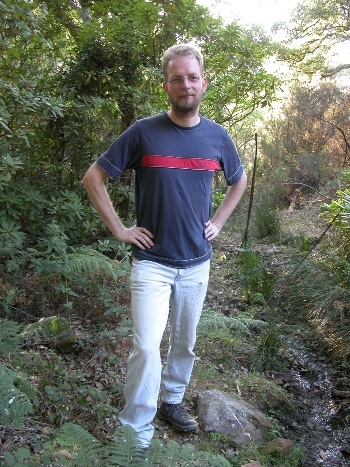 Ecologist Arndt Hampe. Photo courtesy of Arndt Hampe. |
Arndt Hampe: I presume you mean besides a rapid and completely unrealistic reduction of greenhouse gases… Landscape connectivity is definitely a key factor. Climate changes, even rapid ones, are by no means a new phenomenon but have occurred throughout the earth’s history. The new challenge for biodiversity consists in the fact that vast landscapes have been transformed by human activity, severely reducing the connectivity of populations and the spaces available for colonization. Ex-situ conservation [i.e. captive] measures may help in some specific cases, although I think the potential of this option is very limited in comparison with the scale of problems we have to expect for the coming decades.
Mongabay: Would you recommend humans assisting in migration of plant species?
Arndt Hampe: This would be an option, although it involves risks that no theoretical model can seriously predict. The issue is currently an object of hot debate between those who emphasize the potential risks – many conservation biologists – and those who emphasize the potential benefits (or risks of not doing it) – for example foresters who are afraid that wrong planting decisions taken today might condemn forests to doom within a few decades. Ultimately, benefits and risks will depend on the scale of action, that is, the amount of translocations and the distances over which these are conducted. Risks should be relatively low if actions remain limited to ‘assisting range expansion’ in strict sense, that is, if species are not regularly established hundreds of kilometers outside the current distribution. On the other hand, it is key that such actions be carefully designed based on expert knowledge and accompanied by appropriate long-term monitoring to assess success rates (which might be lower than commonly assumed) and possible negative consequences.
Mongabay: What do you think are the most pressing aspects of seed dispersal and climate change that require research?
Arndt Hampe: We clearly need stronger efforts to integrate the different approaches to climate change research and their respective scales. Dispersal ecology has progressed enormously since its early days, some three decades ago, and today we dispose of a solid theoretical and empirical framework. However, this knowledge is virtually ignored by attempts to predict future species distributions through climatic niche modeling. These studies focus mostly on regional to continental scales, inherently assuming that climate is the primary driver of species ranges at these scales and other determinants of population dynamics can be neglected. But fact is that we do not know whether, when and where this is true. On the other hand, it is very difficult to scale up the mechanisms that drive local population dynamics to a landscape or regional scale, and few people have made attempts in this direction. The result is that each researcher community focuses on its scale and many studies are based on assumptions whose validity is far from proven. Global change research has become incredibly diverse within only a few years, and there is a clear need for consolidation and syntheses of this vast amount of knowledge that has been accumulated.
For more information or to contact Dr. Hampe: Arndt Hampe Homepage.
Related articles
(03/07/2010) There are few areas of research in tropical biology more exciting and more important than seed dispersal. Seed dispersal—the process by which seeds are spread from parent trees to new sprouting ground—underpins the ecology of forests worldwide. In temperate forests, seeds are often spread by wind and water, though sometimes by animals such as squirrels and birds. But in the tropics the emphasis is far heavier on the latter, as Dr. Pierre-Michel Forget explains to mongabay.com. “[In rainforests] a majority of plants, trees, lianas, epiphytes, and herbs, are dispersed by fruit-eating animals. […] As seed size varies from tiny seeds less than one millimetres to several centimetres in length or diameter, then, a variety of animals is required to disperse such a continuum and variety of seed size, the smaller being transported by ants and dung beetles, the larger swallowed by cassowary, tapir and elephant, for instance.”
New study: why plants produce different sized seeds
(02/17/2010) The longstanding belief as to why some plants produce big seeds and others small seeds is that in this case bigger-is-better, since large seeds have a better chance of survival. However, Helene Muller-Landau, staff scientist at the Smithsonian Tropical Research Institute and head of the HSBC Climate Partnership’s effort to quantify carbon in tropical forests, grew dissatisfied with that explanation. For example, if big seeds were always the ‘right’ evolutionary path than why would any plants evolve small seeds? In a new paper in the Proceedings of the National Academy of Sciences, Muller-Landau argues for a more complex explanation involving a trade-off between surviving stressful conditions and taking full advantage when the conditions are just right.
Decline in fog threatens California’s iconic redwood ecosystems
(02/15/2010) A surprising new study finds that during the past century the frequency of fog along California’s coast has declined by approximately three hours a day. Published in the Proceedings of the National Academy of Sciences the researchers are concerned that this decrease in fog threatens California’s giant redwoods and the unique ecosystem they inhabit.
Loss in biodiversity may be killing bees
(01/20/2010) A decline in diverse plants species on which to feed may be causing a similar decline in bee survival, according to a new paper in Biology Letters.
Hunting across Southeast Asia weakens forests’ survival, An interview with Richard Corlett

(11/08/2009) A large flying fox eats a fruit ingesting its seeds. Flying over the tropical forests it eventually deposits the seeds at the base of another tree far from the first. One of these seeds takes root, sprouts, and in thirty years time a new tree waits for another flying fox to spread its speed. In the Southeast Asian tropics an astounding 80 percent of seeds are spread not by wind, but by animals: birds, bats, rodents, even elephants. But in a region where animals of all shapes and sizes are being wiped out by uncontrolled hunting and poaching—what will the forests of the future look like? This is the question that has long occupied Richard Corlett, professor of biological science at the National University of Singapore.
Plants recognize that family comes first
(10/16/2009) People like to say ‘blood is thicker than water’. But plants may actually treat ther siblings better than many of us: although lacking in blood, scientists have found that plants not only recognize family, but respect their space.
Will tropical trees survive climate change?, an interview with Kenneth J. Feeley

(09/24/2009) One of the most pressing issues in the conservation today is how climate change will affect tropical ecosystems. The short answer is: we don’t know. Because of this, more and more scientists are looking at the probable impacts of a warmer world on the Earth’s most vibrant and biodiverse ecosystems. Kenneth J. Feeley, tropical ecologist and new professor at Florida International University and the Center for Tropical Plant Conservation at the Fairchild Tropical Botanic Garden, is conducting groundbreaking research in the tropical forests of Peru on the migration of tree species due to climate change.
America’s iconic Midwest forests in significant decline
(06/14/2009) Laura Ingalls Wilder’s beloved series of novels about life in the American frontier begins in Wisconsin with the novel Little House in the Big Woods. Less than a hundred years since its publication, a study in Conservation Biology finds that these Midwestern ‘big woods’ are experiencing a worse-than-expected decline and would likely be unrecognizable to Wilder herself.
Trees in trouble: massive die-offs predicted with global warming
(04/13/2009) An experimental study of pinon pines at Biosphere 2 in Arizona shows that an increase in temperature makes the species more susceptible to die-off during drought. When temperatures were increased by 4 degrees Celsius (7.2 degrees Fahrenheit), the piñon pines died 28 percent faster than trees which experienced drought-conditions at current temperatures, according to a new study published in Proceedings of the National Academy of Sciences (PNAS).
Vanishing forest elephants are the Congo’s greatest cultivators

(04/09/2009) A new study finds that forest elephants may be responsible for planting more trees in the Congo than any other species or ghenus. Conducting a thorough survey of seed dispersal by forest elephants, Dr. Stephen Blake, formerly of the Wildlife Conservation Society (WCS) and now of the Mac Planck Institute for Ornithology, and his team found that forest elephants consume more than 96 species of plant seeds and can carry the seeds as far as 57 kilometers (35 miles) from their parent tree. Forest elephants are a subspecies of the more-widely known African elephant of the continent’s great savannas, differing in many ways from their savanna-relations, including in their diet.
Plant communities changing across the globe, says scientist Sasha Wright
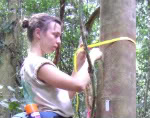
(03/29/2009) Having studied plant communities across three continent and within widely varied ecosystems—lowland tropics, deciduous forests, grasslands, and enclosed ecosystems on hill-tops—graduate student Sasha Wright has gained a unique understanding of shifts in plant communities worldwide as they respond to pressures from land use and global climate change. “Plant communities are certainly changing,” Wright told Mongabay.com in a March 2009 interview. “These changes are undoubtedly affected by an increased occurrence of extreme weather events, temperature fluctuations, atmospheric CO2 concentrations, human land use, and in some cases urbanization of populations.”
Loss of genetic diversity hurts agriculture

(03/23/2009) Agriculture has long been dependent on the ability of plant species to adapt to varying environmental conditions — without this diversity agriculture development would not have been possible. But human activities are putting this diversity at risk through habitat destruction and introduction of alien species, especially in parts of the world where such diversity is particularly critical: tropical developing countries. This threat has spurred increased efforts to find and conserve plants with special traits adapted to the marginal farming systems of tropical smallholders.
Regrowing the Amazon rainforest will require help from bats and birds
(09/15/2008) As large tracts of Amazon rainforest are degraded by industrial logging and cleared for cattle pasture and agriculture, other deforested areas are abandoned and being reclaimed by forest. Understanding this recolonization of degraded forest lands by pioneer species will critical to efforts to rehabilitate restore forests around the world.
Global warming causes plants to move to higher elevations
(06/26/2008) Global warming has caused many plant species to move to higher elevations, report researchers writing in the journal Science.
New discoveries about past forest changes may help predict future ones in a changing climate
(06/12/2008) There is no better method to understand the future than to look to the past. Several new studies of the earth’s glacial history are transforming the way scientists look at tree behvaior during extreme changes in climate. Scientists Remj Petit, Feng Sheng Hu, and Christopher Dick described such changes in relation to current global warming in the new issue of the journal Science. They report that already “in some parts of the world, tree species have started to shift their distributions in response to anthropogenic climatic warming”, thus raising the stakes for understanding how tree species will adapt to coming changes.

